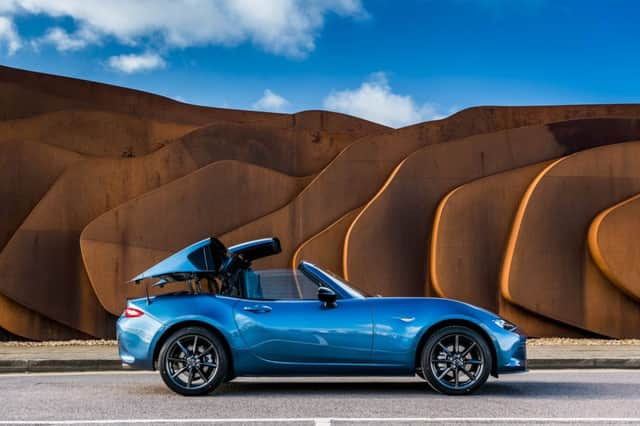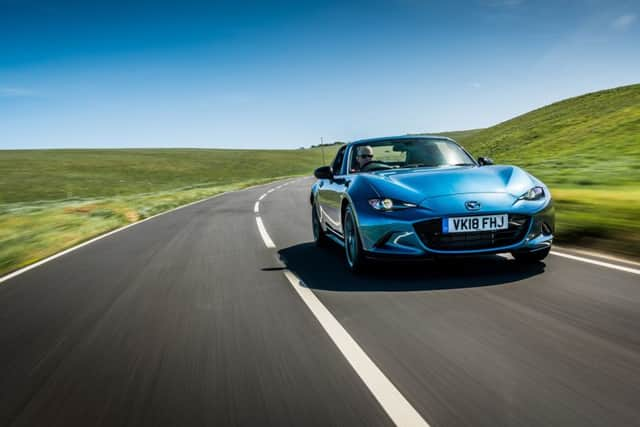Review: Mazda MX-5 RF 2.0


Morgans are still being made by hand in the Malvern Hills. I was reminded of that summer drive – obtusely by a late autumn drive in the car which revived the appeal of the British two-seater sports car. The light was fading, the skyline was red-lipped as the sun slipped away. There was no heat, but the moors and peat banks had been dampened by rain and shared their earthy reek.
Later, down in the trees, I heard the squawk of rooks and crows as they settled down for the evening. All this – the smells, the noises, the chattering of tyres on the hairpin bends, the closeness of it all – were evident because the roof of the Mazda was open. I remembered this was why I like open cars.
Advertisement
Hide AdAdvertisement
Hide AdThe Mazda MX-5 arrived last century, Japan’s embodiment of those post-war Triumph, MG and Lotus two-seaters which were fading from our catalogues.


It came from Hiroshima – a phoenix from the city wasted by an atomic bomb 44 years earlier. The MX-5 became the world’s best-selling sports car. It is 30 years old next year. It remains a small, light car with a front engine driving the rear wheels. The roof is fabric. More recently, a folding hard top was offered. Now we are back to fabric and the car tested here, the RF. I’ll try to think what RF might mean. It has a fixed rear cowl section and central roof panels which fold away behind the seats quicker than you can say… well, not very long, just by pressing and holding a switch.
Some convertible roofs can be retracted and raised at 20 or 30mph. On the Mazda RF the speed must be under 6 mph – so it’s not the sort of move you’d attempt at traffic lights in case they change and catch your RF partly dressed. You’ll only make this mistake in timing once – or in my case, I’m a slow learner.
What you have is a semi-open car, a compromise between the complete flat deck of the roadster and the shut-up carapace of a coupé. In its closed position the RF looks very sleek and sportily nice from most angles.
It was revised this year and you can still get the 132ps 1.6 roadster SE for a fiver under £19,000 and the RF SE-L 1.6 with navigation from £22,595. The 2018 update brought a new higher revving 2-litre engine, now delivering 184ps. Prices start at £22,295 for the SE-L Nav convertible and £24,095 for the RF. You’ll probably want one of Mazda’s stunning metallic paints, like soul red at £550 or the luscious machine grey seen here for £670. These prices are with the snappy six-speed manual gearshift. Automatic gears are offered only with the 2-litre RF from £27,995. All models now have in/out adjustment for the steering wheel and easier seat adjustment.
My demo car was the 2-litre RF Sport Nav, from £26,595. The specification includes sports suspension with Bilstein dampers, front strut braces, glossy grey 17-inch wheels, clever adaptive and brilliantly bright LED anti-dazzle headlamps, Bose audio and traffic sign recognition. The black leather seats have red stitching. Safety additions include front and rear city braking, rear-cross traffic alert with a reversing camera and an active lane departure warning. Price as tested: £28,065 with the grey metallic paint.
A key phrase in planning the latest MX-5 was to innovate in order to preserve. In other words, don’t let a design get too stale. Chief designer Masashi Nakayama talks about an “unceasing commitment to refining the vehicle over its 29-year history” to maintain its appeal. However, there are some who prefer the previous less angular body shape.
Mazda quotes 40.9mpg and 156g for the 2-litre RF with a 6.8-second time for the 0-62 sprint – which it will just about achieve in second gear at nearly 8,000rpm. It’s probably not something you’d do regularly, because the engine starts screaming much beyond 7,000 revs.
Advertisement
Hide AdAdvertisement
Hide AdI like to think the 2-litre engine enjoyed being caned. The exhaust note of the uprated 2-litre engine encourages spirited driving – supported by taut and sure handling. That said, the car is quieter and a bit tighter with the roof closed – shutting out the wind roar which bounces around the cockpit with the roof panel open. On the motorway at 70-ish you’ll have the roof closed. At lower speeds it’s reasonably OK and rain skims overhead.
I took it on some sample drives. A familiar town, motorway and country 50-mile route returned 44mpg. A brisker and more demanding 70-miler into the hills and curving, undulating backroads was still nudging 40mpg. The bouncy roads caused some thudding in the rear, as if an item was loose in the boot. It wasn’t.
Verdict: Lovely, but I’d take the open roadster version.